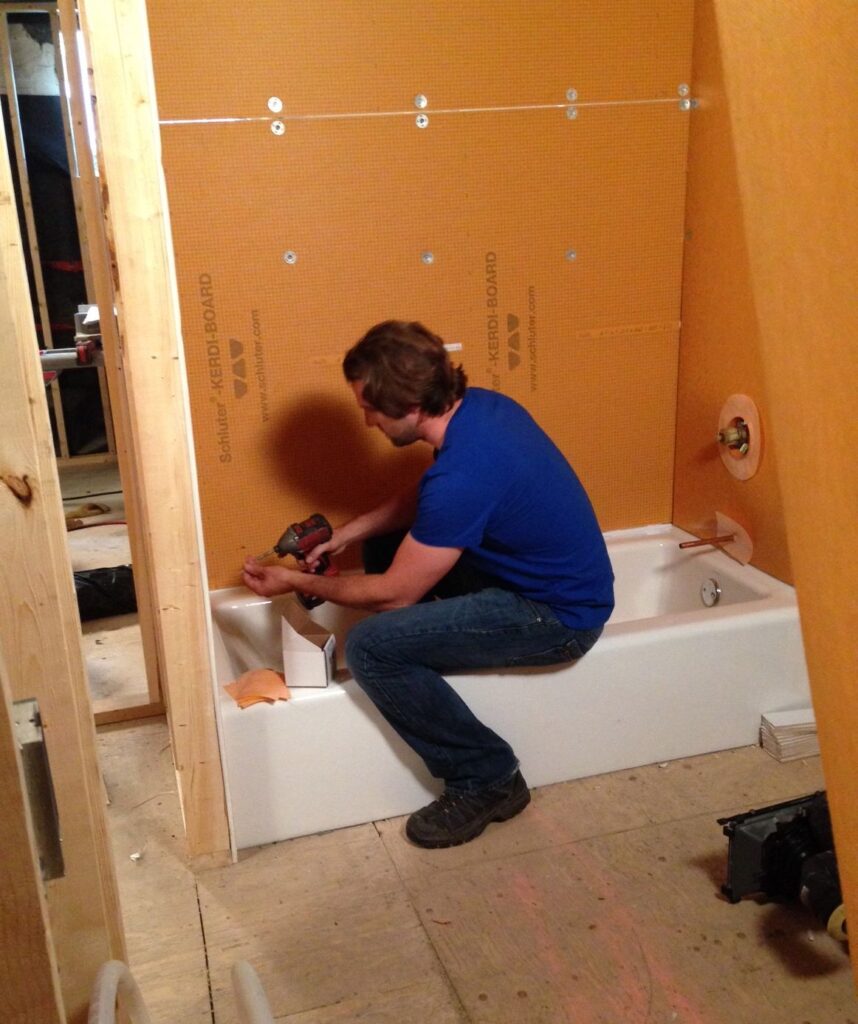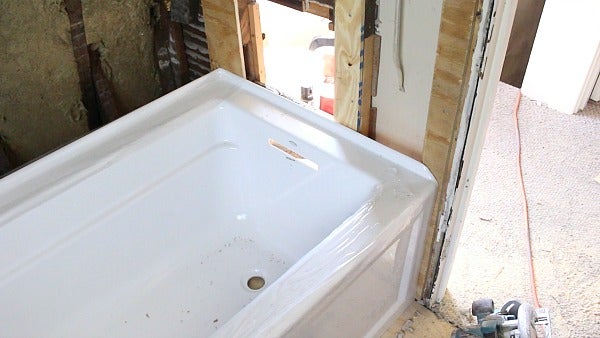Plumbing Basics: Before Bathtub Installation
Plumbing Basics: Before Bathtub Installation
Blog Article
Just how do you actually feel about How to Install a Bathtub: Install an Acrylic Tub and Tub Surround?

Mounting a bathtub isn't specifically rocket science, yet it does need solid plumbing, woodworking, and in some cases, tiling skills. Changing an old bathtub with a brand-new one is likewise a reasonably difficult task. If the old bathtub is readily accessible, the job can relocate easily; if you need to open up a wall surface to eliminate the old tub as well as position the brand-new tub, the job is a lot harder. In either case, the job is within a residence handyman's abilities, although you will certainly need a helper to vacate the old tub as well as set in the brand-new one. Ensure you have actually certified on your own for the work and fit trying it. Rather than working with a professional to take control of a halfway-completed task, it is better to think about employing one prior to you begin. Chances are you might require an expert plumber to make tube connections.
This article will aid you install a brand-new tub in your washroom if you have currently gotten a new tub and do not require to alter the plan of your previous water pipes.
Your tools as well as product checklist ought to make up the following:
Removing Old Touches
If you require to change old faucets with new ones as a part of your installment, then the first thing you need to do is separate the supply of water. After doing so, activate the taps to drain any kind of water remaining in the system. The procedure of removing the existing faucets can be quite bothersome because of the restricted gain access to that is usually the case.
Make use of a container wrench (crowsfoot spanner) or a faucet tool to reverse the nut that attaches the supply pipes to the taps. Have a towel ready for the remaining water that will originate from the pipelines. When the supply pipes have been eliminated, make use of the same device to loosen up the nut that holds the taps onto the bath/basin. You will need to stop the solitary taps from transforming during this process. As soon as the taps have been gotten rid of, the holes in the bath/basin will certainly need to be cleaned up of any type of old sealing substance.
Prior to carrying on to fit the brand-new taps, compare the pipeline connections on the old faucets to the brand-new faucets. If the old faucets are longer than the new taps, then a shank adapter is required for the brand-new taps to fit.
Suitable New Touches
If the tails of the new faucets are plastic, then you will need a plastic connector to avoid damages to the string. One end of the connector fits on the plastic tail of the faucet and the various other end gives a link to the existing supply pipes.
If you require to fit a monobloc, after that you will certainly need minimizing couplers, which connects the 10mm pipe of the monobloc to the basic 15mm supply pipe.
Next, position the faucet in the mounting opening in the bath/basin making certain that the washers remain in area in between the faucet and the sink. Safeguard the tap in position with the manufacturer provided backnut. When the faucet is securely in place, the supply pipes can be connected to the tails of the taps. The faucets can either be linked by utilizing corrugated copper piping or with regular faucet connectors. The previous kind should be connected to the tap ends first, tightening just by hand. The supply pipelines can later be linked to the various other end. Tighten both ends with a spanner after both ends have actually been linked.
Mounting the Bath tub
Utilizing both wooden boards under its feet, put the tub in the needed setting. The wooden boards are valuable in evenly spreading the weight of the bathtub over the location of the boards as opposed to focusing all the weight onto four small points.
The next goal is to ensure that the bathtub is leveled all round. This can be accomplished by checking the spirit level and also readjusting the feet on the tub till the level checks out degree.
To install taps, fit all-time low of the outermost versatile faucet connector to the ideal supply pipeline by making a compression join; after that do the very same for the various other tap.
Switch on the water supply and inspect all joints and brand-new pipework for leakages and tighten them if necessary. Fill up the bath tub as well as also check the overflow outlet and the typical electrical outlet for leakages.
Ultimately, fix the bath paneling as explained in the supplier's instruction manual. Tiling as well as sealing around the bath tub ought to wait till the tub has been used at the very least once as this will certainly settle it right into its final placement.
Preparing for the Installation
Firstly, the supporting structure provided with the bathroom ought to be fitted (if needed) according to the manufacturer's guidelines. Next off, fit the taps or mixer to the bath tub. When suitable the tap block, it is essential to make certain that if the tap features a plastic washing machine, it is fitted between the bath and the taps. On a plastic bath, it is also practical to fit a sustaining plate under the taps unit to prevent strain on the bathtub.
Fit the versatile tap ports to the bottom of the two faucets making use of 2 nuts and also olives (occasionally provided with the bathtub). Fit the plug-hole electrical outlet by smearing mastic filler round the sink electrical outlet hole, and afterwards pass the electrical outlet with the hole in the bathroom. Use the nut provided by the manufacturer to fit the plug-hole. Check out the plug-hole electrical outlet for an inlet on the side for the overflow pipe.
Next, fit the end of the adaptable overflow pipe to the overflow electrical outlet. Afterwards, screw the pipe to the overflow face which need to be fitted inside the bath. See to it you make use of all of the supplied washing machines.
Attach the trap to the bottom of the waste electrical outlet on the tub by winding the string of the waste outlet with silicone mastic or PTFE tape, and also screw on the catch to the outlet. Connect all-time low of the overflow tube in a similar manner.The bath should currently prepare to be suited its final position.
Tiling Around the Bathtub
In the area where the bathroom satisfies the tile, it is essential to seal the joins with a silicone rubber caulking. This is essential as the fitting can move enough to crack an inflexible seal, triggering the water to permeate the wall in between the bathroom and the tiling, leading to complications with moisture and also possible leakages to the ceiling below.
You can choose from a variety of coloured sealants to blend in your components and installations. They are marketed in tubes and cartridges, as well as are capable of sealing gaps up to a size of 3mm (1/8 inch). If you have a larger space to fill up, you can load it with twists of drenched newspaper or soft rope. Bear in mind to always load the tub with water prior to sealing, to allow for the motion experienced when the bathtub is in use. The sealer can fracture relatively early if you do not consider this activity prior to securing.
Alternatively, ceramic coving or quadrant floor tiles can be made use of to border the bathroom or shower tray. Plastic strips of coving, which are easy to use as well as reduce to size, are also quickly readily available on the market. It is a good idea to fit the ceramic tiles making use of water-resistant or waterproof adhesive and also grout.
Bathtub Installation
How Important Is A Bathtub To Your Home?
High-quality baths, showers, and other bathroom updates are necessary when considering a smart investment in your home. It’s a room that you go to every day and one that is constantly being used by guests.The bathroom is one of the top trafficked rooms in a home and also one of the most valuable in terms of home resale.
Install Piping Before Tub
You will be using your existing drain and waste vent system, but pipes required include the hot and cold water supply lines and a pipe leading to a shower head. A mixing valve and shower head are also needed. Air chambers may be required.
Position the Tub
Lower the tub into place so that the continuous flange fits against the wall studs and rests on 1’x4' or 2’x4' supports. Anchor the tub to the enclosure with nails or screws inserted through the flanges into the studs.
NOTE: Remember, bathtubs and shower stalls may require support framing. A bathtub filled with water is extremely heavy, so check building codes and framing support before installing the tub.
Assemble Drain Connections
Assemble the bathtub drain connections by connecting the tub overflow with the tub drain above the trap, not beyond it. The trap will have a compression fitting that screws over the arm of the overflow assembly.
Place a Pipe For the Shower Head
First, locate a brass female threaded winged fitting and attach it to a framing support via a screw or a nail. Then run a pipe up the wall for the shower head. Sweat or solder the other side of the brass fitting to the top of the pipe.
Attaching Hot and Cold Water Lines
Attach your water lines for both hot and cold by sweating these directly into the hot and cold ports of the mixing valve. The mixing valve will be how water enters the tub’s system, not by the pipes themselves.
Install the Spout
Extend a piece of 1/2 inch pipe, or whichever length is specified in the manufacturer’s instructions, for the tub spout. Sweat on a male threaded fitting at the end of the pipe or use a brass nipple of the proper length and a 1/2 inch cap.
NOTE: At this point you should have your rough-in plumbing work inspected before proceeding further.
Check For Leaks
Restore the water pressure and check the drain connection and the supply pipes for any sign of leaking.
estore the Bathroom Wall
Replace the wall with moisture-resistant drywall as a base for your wall covering. Seal the joints between the wall and your new tub with silicone caulk as protection against water seepage.
https://www.berkeys.com/2016/12/02/bathtub-installation-dallas/

I am very taken with Installing A Bathtub and I am assuming you enjoyed the new entry. Be sure to set aside a second to distribute this post if you appreciated it. I treasure reading our article about Installing A Bathtub.
We're ready, dial now! Report this page